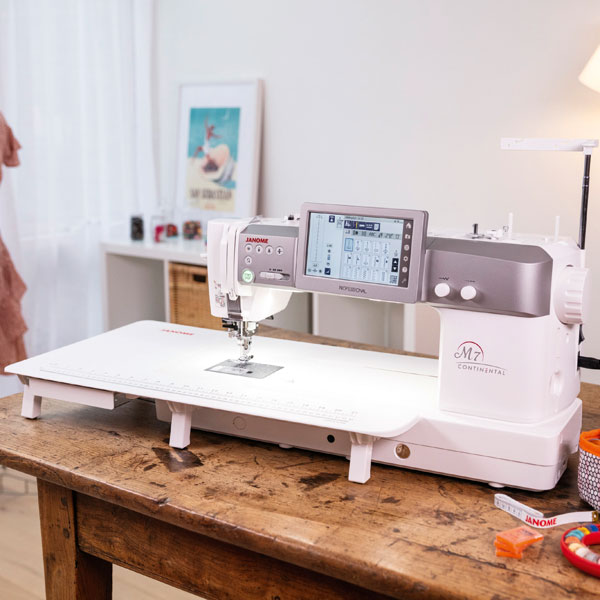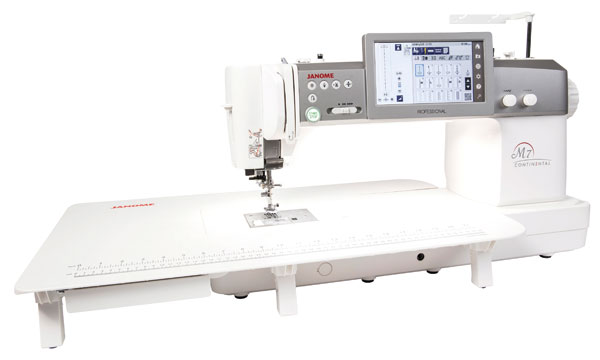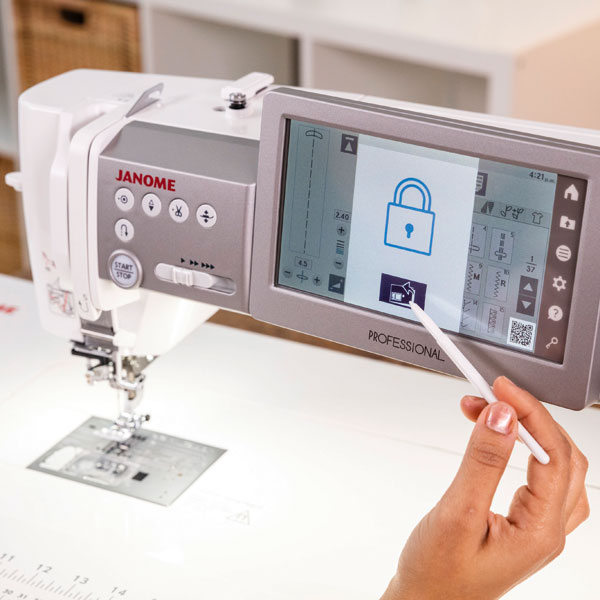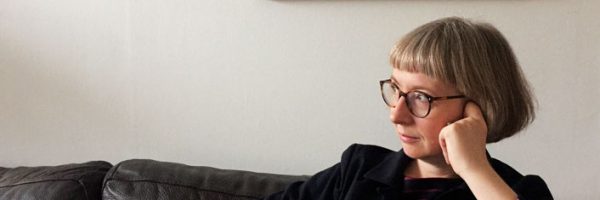
Road Test: Janome Continental M7 Professional Sewing Machine
Playing with a new model of sewing machine is always enjoyable, but this machine was so much fun! The Janome Continental M7 Professional is a heavy-duty, well-thought-through sewing machine. While it may have the word Professional in the title, it certainly has all the attributes a home quilter would want as well. Given the length of this article, I won’t be able to mention all the inclusions of this fantastic machine. You will need to test drive it at your local Janome dealer to find out all the fabulous features for yourself.
To start with, the first thing you will notice is the overall size, and weight, of the machine. The machine weighs 17.3kg (38lb), with a rigid die-cast aluminium frame, making it very stable at any speed. The sewing area from the needle to the right side of the body of the machine is an impressive 34.3cm (13½in). An extension table slides onto the basic machine, extending your sewing area to the left, front and back. With this in place, the machine measures 88cm (35in) from the left edge of the table to the edge of the machine on the right side. The extension table is included with the machine when you purchase it, and also has a handy drawer located in the front. In this drawer you can store the two extra needle plates that come with the machine, plus bobbins, screwdriver and some feet. The machine comes with 23 feet — you need to store those not in current use in the convenient accessory box.
Make the Cathedral Window sewing machine cover with Cheryl Houghton’s pattern
Once it is physically set up, the real fun starts. The machine has a 18cm (7in) LCD display screen through which you can access any of the 400 built-in stitches, memorise your favourites, adjust the feed on the Dual Feed (walking foot), or even check the time. The stitches are in different folders and are easy to access. The recommended foot for the stitch is displayed on screen and the image of the stitch changes on screen if you make adjustments. One interesting feature is the Tapering feature on some of the decorative stitches. You can choose from different angles, different directions and choose your own length of taper. Now I admit, I have not tapered anything recently, but I have completed a lot of machine appliqué. On this machine there is a selection of 20 different stitches, including single and double blanket stitch, an adjustable mock hand appliqué stitch, satin stitch and grass stitch. The blanket stitch not only comes in the heavy or light varieties, but you can select if you wish it to run in the middle of the foot, to the left or right, and also mirror imaged. An open toe satin stitch foot is included with the machine for use with all appliqué stitches.
Now, while we do appliqué, most of us tend to piece more frequently. This machine gives you so many options. It comes with two ¼in feet, one with the black metal guide, one without. They work with a dedicated ¼in seating on the machine (or 7mm should you wish). It automatically shortens the stitch length, and you can also program the length of the seam that you want. Why would you want this feature? If you are doing an inset seam, where you need to sew to a point, not the whole length of the seam, you could stitch the first seam, then have the length set for the subsequent seams. Saves some unpicking!
Have you ever had your machine ‘eat’ the end of a piece of fabric?
When the sewing foot is raised on this machine, the feed dogs automatically drop below the needle plate, allowing your project to easily slide under the foot. The standard needle plate on the machine has a 9mm (1/3in) opening to allow for the width of the largest stitch. However, you can place the included Straight Stitch Plate on the machine with the ¼in foot and this closes up the opening. This particular Straight Stitch Plate actually has three holes so that you can use it with a variety of feet. The holes are in the centre, left and right. Or maybe you still need more? Another foot that you choose to use on this machine is the Professional grade foot, which is also ¼in from the centre needle position to the edge of the foot. This is not a clip-on foot, but has an attached upper section that needs to be screwed into place on the machine, making this foot much firmer as there is absolutely no play in it. It has a dedicated needle plate that works in conjunction with the foot. Changing the needle plate is extremely easy: hit a lock button on the LCD screen and an icon appears. Press the icon and the plate automatically releases. Simply remove and put the new plate in place. Unlock the machine and you are ready to sew. Makes cleaning the drop-in bobbin race area very simple.
Piecing and appliqué are only part of our patchwork journey: we need to quilt to complete our projects. Included are eight different quilting feet, and two darning feet that can also be used for free-motion quilting. For straight line work, a Dual Feed foot attaches to the machine and, once the machine knows it is there, you can actually adjust the amount of feed if you have a layer of fabric that is puckering. You can also adjust the pressure of the foot to cope with different thicknesses. Five variable options appear on screen when using the Dual Feed: no swapping screens, it is all in the one place. As it is not a traditional walking foot, it does not have the bulk out the back, but still works as an upper seat of feed dogs.
Create a fun, scrappy bag with patches and lots of embellishment using Masako Wakayama’s bag pattern
For free-motion quilting, your foot would depend on your project. Closed- and open-toe darning feet with a spring mechanism are the normal feet you might find with a machine. But this one also comes with free motion feet designed for use with zig-zag, and a dedicated ruler foot with the thicker base ring with a fixed upright for steadiness. This foot is used to work with the thickness of the rulers and create even curves, or free-motion straight lines. It extends the type of free-motion quilting you can do on this machine. If you are familiar with a long-arm machine, this is the style of foot that it used on these machines. The machine is capable of stitching 1300 stitches per minute, due to the motor. The heavy base of the machine means that it is very stable when stitching at this speed. The machine was effortless while free-motion quilting, and both top and bottom tension were even. The large extension table gives both hands somewhere to rest while pushing the quilt around under the needle. The knee lifter allows hands-free adjusting as you raise and lower the foot with your leg. Or, engage the pivot button and adjust when you stop sewing. You can also tell the machine whether you are working on a thin or thicker project and it automatically adjusts for you.
There is so much in this. There are nine LED lights in four locations to illuminate your sewing area. If you walk away, it has an eco mode and the lights turn off until you return and start sewing again. The LCD screen also dims and has a rotating set of images as a screen saver. An Auto-off Timer will automatically turn off the power if the machine is idle for seven hours. You can set the power-off timer anywhere from one to 12 hours. The bobbin winder is a separate motor. A button by the bobbin winder at the top of the machine switches it on and off. You can wind a bobbin while still sewing. Two thread stands are located at the back of the machine, with a telescopic arm taking the thread up before down through any tension mechanisms. This machine does not require the foot control to sew: you can control the machine with the Start/Stop button and controlling the sewing speed with the Speed Slider button. This is a great feature for sewists who are handicapable.
There is a button on the front of the machine for the automatic thread cutter. When it is pressed, both sewing threads are cut and pulled to the back of the fabric. You can also program it to cut when the auto lock off button is selected: the stitch is locked off and the auto thread cutter will then trim both threads, top and bobbin.
Learn to crazy patchwork on your sewing machine
All the basics are included in the stitch selection, with 13 varieties of buttonhole types, four fonts plus symbols, embroidery stitches for crazy patchwork or other decorative work, plus a Sashiko look and hand quilt stitch. Another unique feature is the Sewing Application folder on the LCD screen. One folder is dedicated to 22 normal sewing techniques, while a second folder showcases 10 different techniques you may choose to use when making a quilt. When you select the function in this folder, it will show the foot required and adjust the width, length or tension if required. If something can’t be done with the foot or needle plate currently on the machine, it will be greyed out. The third folder has nine less-common techniques, like beading, ruffling, cording, pintucking, and even ultraglide for leather and vinyl. These Sewing Applications are for Optional Feet, which can be easily attached. Then, select the Sewing Application technique and stitch. And you can customise any stitch and save it if you have the Favourite Stitch Adjustment selected in the menu. You have four or five adjustments depending on the stitch: needle position, stitch length, stitch width, tension and foot pressure.
The only downside that I found with this machine is that you would not want to be carrying it around too much for workshops. But the very weight of it is also a reason to buy it — the large motor, excellent stitching and stability, with all mod cons thrown in. A unique feature of the CM7P is the QRBarcode on the bottom right of the LCD screen This works in conjunction with the free Janome AcuSpark app, which is downloadable from the Apple Store or Google Play. This modern interpretation of a manual works by scanning the QR Code for super quick access to Stitch Information, Foot details, How-to Videos, Stitch Chart with images of sewn stitches, Sewing Applications, Machine Functions and Parts, Manual stitch settings, Touch screen keys, general instructions and tips.
For more information contact Janome – free call 1300 526 664, email: enquiries@janome.com.au
or visit the website: www.janome.com.au





